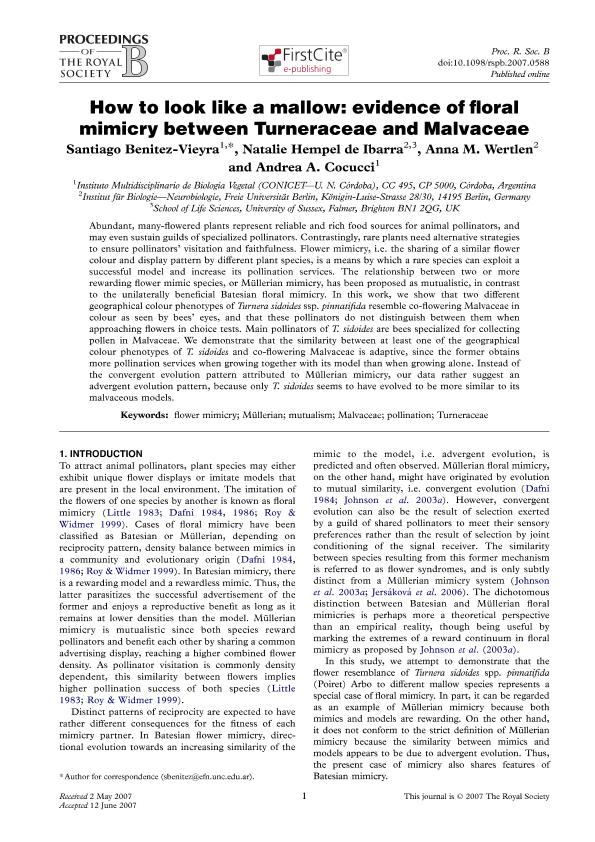Artículo
How to look like a mallow: evidence of floral mimicry between Turneraceae and Malvaceae
Benitez-Vieyra, Santiago Miguel ; Hempel de Ibarra, Natalie; Wertlen, Anna M.; Cocucci, Andrea Aristides
; Hempel de Ibarra, Natalie; Wertlen, Anna M.; Cocucci, Andrea Aristides
 ; Hempel de Ibarra, Natalie; Wertlen, Anna M.; Cocucci, Andrea Aristides
; Hempel de Ibarra, Natalie; Wertlen, Anna M.; Cocucci, Andrea Aristides
Fecha de publicación:
09/2007
Editorial:
The Royal Society
Revista:
Proceedings of the Royal Society of London. Series B: Biological Sciences
ISSN:
0962-8452
e-ISSN:
1471-2954
Idioma:
Inglés
Tipo de recurso:
Artículo publicado
Clasificación temática:
Resumen
Abundant, many-flowered plants represent reliable and rich food sources for animal pollinators, and may even sustain guilds of specialized pollinators. Contrastingly, rare plants need alternative strategies to ensure pollinators’ visitation and faithfulness. Flower mimicry, i.e. the sharing of a similar flower colour and display pattern by different plant species, is a means by which a rare species can exploit a successful model and increase its pollination services. The relationship between two or more
rewarding flower mimic species, or Mullerian mimicry, has been proposed as mutualistic, in contrast to the unilaterally beneficial Batesian floral mimicry. In this work, we show that two different geographical colour phenotypes of Turnera sidoides ssp. pinnatifida resemble co-flowering Malvaceae in colour as seen by bees’ eyes, and that these pollinators do not distinguish between them when approaching flowers in choice tests. Main pollinators of T. sidoides are bees specialized for collecting pollen in Malvaceae. We demonstrate that the similarity between at least one of the geographical colour phenotypes of T. sidoides and co-flowering Malvaceae is adaptive, since the former obtains more pollination services when growing together with its model than when growing alone. Instead of the convergent evolution pattern attributed to Müllerian mimicry, our data rather suggest an advergent evolution pattern, because only T. sidoides seems to have evolved to be more similar to its malvaceous models.
Palabras clave:
Flower Mimicry
,
Mutualism
,
Malvaceae
Archivos asociados
Licencia
Identificadores
Colecciones
Articulos(IMBIV)
Articulos de INST.MULTIDISCIPL.DE BIOLOGIA VEGETAL (P)
Articulos de INST.MULTIDISCIPL.DE BIOLOGIA VEGETAL (P)
Citación
Benitez-Vieyra, Santiago Miguel; Hempel de Ibarra, Natalie; Wertlen, Anna M.; Cocucci, Andrea Aristides; How to look like a mallow: evidence of floral mimicry between Turneraceae and Malvaceae; The Royal Society; Proceedings of the Royal Society of London. Series B: Biological Sciences; 274; 1623; 9-2007; 2239-2248
Compartir
Altmétricas



